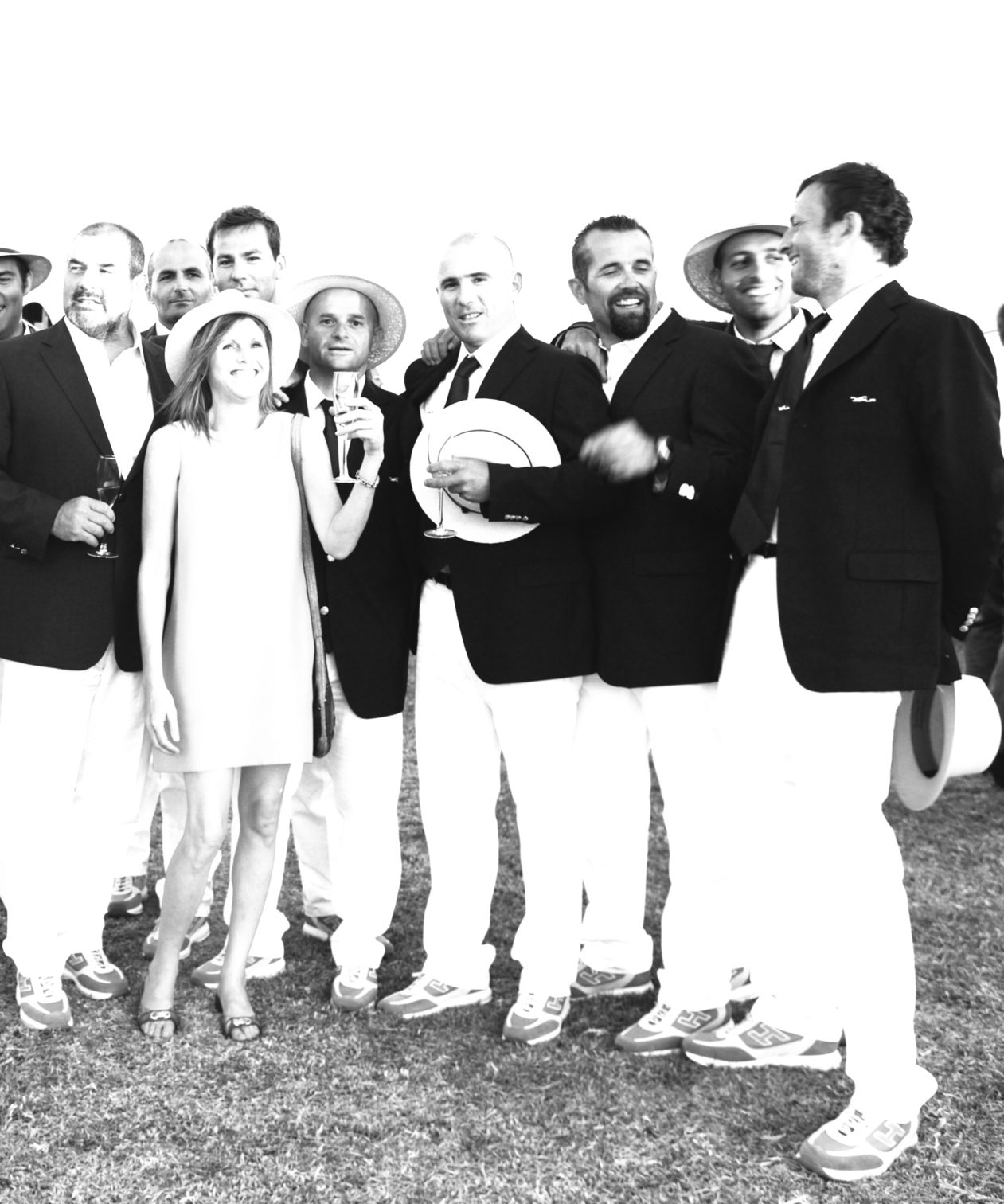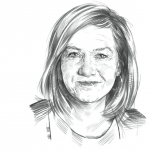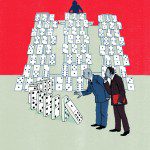One of a Kind
Whether posing with an Italian regatta team or commanding a masthead, Linda Lewis was in a class of her own

Linda Lewis always had a clear idea of what she wanted. Caroline Connell, who worked with her at Today’s Parent, could see the gears of her mind turning as she listened to art concepts. She’d say, “Yeah, that’s great, but I think it should be like this,” before presenting little sketches she’d just drawn during the discussion. “What do you think?” Lewis would ask. The staff teased her about her terrible drawings, but they always knew that what she came up with was good. “She would sort of pretend to entertain everyone else’s ideas,” says Connell, “but she pretty much had it figured out herself.”
Later, when Lewis had a chance to create a Canadian edition of More, an American lifestyle magazine, she knew what she wanted it to reflect: the looks, lives and desires of women 40 and over. When it launched in 2007, she wrote in her Letter from Linda: “You’ve reached middle age when all you exercise is caution. I read this sentence every day because it is written on my bathroom wall.” She admitted that although she was the first (and likely the last) person to purchase such kitschy wallpaper, she didn’t believe a word of it. Then 46, Lewis embraced her age—even if it meant having a muffin top around her waist, losing her glasses on top of her head or accidentally wearing two mismatched boots to the office.
For Lewis, who died of leukemia in July 2013, being an editor came naturally. Thanks to her open and honest relationship with readers, her perseverance to get the best stories and a good sense of humour, she led a successful career—even as the Canadian magazine industry faltered.
***
Lewis and her identical twin, Leora Eisen, were both bookworms growing up, even turning reading into a competition. “She read Anna Karenina and War and Peace first,” says Eisen. “So I had to read them.” They both went into journalism, though Lewis chose magazines while her sister became a TV documentary director. After completing her master’s degree at Syracuse University in New York in the mid-1980s, Lewis wrote for several of Canada’s top magazines, including Saturday Night, enRoute and Chatelaine. Although general interest publications had long been in trouble and no one was getting rich, there was still a lot of work for freelancers.
In 1993, Lewis joined Today’s Parent as managing editor. As a mother of two young children, she always had many story ideas, so former editor-in-chief Fran Fearnley, who wasn’t a parent, relied on Lewis’s judgment. It also didn’t hurt that she could write well. “She was an excellent writer, which isn’t always the case with every editor,” says Fearnley. “She had such a wonderful way of combining important commentary with a light touch and bringing in examples from her own life.”
When Lewis took over as editor in 1997, she wrote editorials about her own experiences as a mother. In “The Facade of Competence,” she discussed four then-recent events: First, “‘Mom’s a really good. . . uh. . . speller!’” she wrote. “When asked what they thought I was good at, this is the response my two bright and adoring children came up with. Yup. That’s it.” Second, when a dinner guest asked what her best dish was, Lewis just stared at him as she served cold leftovers made by the nanny. Third, after a friend said she rarely yelled at her kids, “Casey and Nikki are looking at her longingly; they probably want to trade mothers.” And fourth, after messing up carpool plans, Lewis admits: “I phoned Barb when I finally remembered at 11:21 a.m., and announced that I should be fired from my job at a parenting magazine.”
There was no danger of that. Today’s Parent flourished during Lewis’s nine years as editor-in-chief, which was all the more impressive given the upheaval in the industry at that time. A recession in the early ’90s hurt advertising sales, and then came the internet. It provided a platform for cheap, seemingly endless content tailored to specific demographics, unleashing new competitors like online magazines and blogs. Some print magazines failed while many struggled. But Today’s Parent had its niche and knew how to serve it, says D.B. Scott, a Canadian magazine blogger, consultant and president of Impresa Communications Ltd. The online threat was hard to ignore, so Today’s Parent filled its website with articles from the print edition as well as blogs, videos, contests and sponsored content.
Lewis also launched For Kids’ Sake, a program celebrating people making a difference in children’s lives. Each year, from 2004 to 2011, it awarded up to $10,000 to recipients and their charities. Ildiko Marshall, former group publisher and vice-president of the Today’s Parent Group at Rogers Publishing says, “The magazine was incredibly successful—she was a fabulous leader for the editorial.”
By 2006, it was time for a new challenge. At 45, her children now teenagers, Lewis became founding editor-in-chief of More Canada and asked senior editor Sarah Moore from Today’s Parent to join her. The magazine ran articles such as “This is What 52 Looks Like” and “More Beautiful at 40 Than at 20?” as well as pieces on everything from acne, weight and exercise to cosmetic surgery, menopause and cancer. Features celebrated women who were doing what they loved, making a difference and starting over. For example, “Bear Essentials” was about a woman who guided tourists through the polar bear habitat of Churchill, Manitoba, and “Church and Fate” profiled an editor who became an Anglican deacon. “It’s a lot about being comfortable in our own skin. We’ve lived a few years, know what we want and that’s a lot of what the magazine is about,” Lewis said in a 2008 interview on CTV. “I think it’s about accepting who you are and what you are doing and recognizing that there’s still a lot of living left to do.”
One of her favourite interviews was with Michaëlle Jean, and she later wrote about how much she liked and respected the Governor General—though she thought it was unprofessional to admit—because Jean was just like other women. In fact, Jean was late to the photoshoot and interview because she’d squeezed in much-needed time with friends. The two women hit it off and continued to write each other. Just before Lewis died, she received Jean’s last note.
At More, Lewis wrote openly about her life, weight (she was often accused of being too skinny), relationships, divorce, being a single parent of two teens and the ups and downs of getting older. In September 2008, she discussed meeting her readers. At a corporate luncheon one woman told her, “When I read your editorials, I feel like I’m sitting on the couch right next to you, chatting over a glass of wine.” On the subway, a woman next to her said, “Excuse me, are you Linda Lewis from More? I’m 46 and I totally get it.”
***
When Lewis started at Today’s Parent, the magazine operated out of an old three-storey brick building in downtown Toronto. Editors worked from home, but when they came into the office, they perched wherever there was room; it was a fun and engaging space. At the time, Lewis was a busy wife and mother, but she never tired of work. Connell says Lewis’s mind was always on the magazine. It was not uncommon for her to assign pieces “absurdly far in advance” and she always finished ahead of deadline. She was also an insomniac, according to Connell. “She used to come back with manuscripts that she’d written her notes on, and say, ‘Yeah, I did that one at four in the morning because I couldn’t sleep.’”
Lewis also pushed her editors and writers to do their best work. Vanessa Craft, who was a beauty editor at More, says Lewis was open-minded when her staff came to her with ideas, but she also challenged their reasoning to ensure their suggestions were appropriate for the magazine. “Linda always put the readers first and made you view your ideas, your stories and editorials through their eyes,” says Craft. She often received comments such as “jargony and press release-y” on her drafts. Dan Bortolotti, who wrote for Today’s Parent and More, sometimes grumbled as Lewis sent him away to re-interview and rewrite, but could never deny that her feedback made his work better. He valued her ability to improve stories while still maintaining the writer’s voice.
Lewis was just as demanding at home, where she would dock her son Casey’s allowance for grammar mistakes on his homework. She also showed no mercy as a Scrabble player. Tim Pennock, Lewis’s boyfriend during the last four years of her life, admits that he never expected to win a game and he considers the few times he managed to stump her to be victories.
But Lewis was forgetful. It was not unusual for her to come to the office wearing jeans inside-out. Faith Cochran, More’s art director, says Lewis wasn’t big on formal meetings, so she was more likely to run from office to office as thoughts came to her. If she didn’t, the idea might have left her mind as quickly as it arrived.
When Lewis was away on medical leave due to cervical cancer in 2000, her staff picked up the slack. Bortolotti had never worked so hard, but he and his colleagues wanted to make her proud. It was a test for those in the “School of Linda,” a test he feels they passed thanks to her training. “Everything we do now,” says Craft, currently beauty director of Elle Canada, “is filtered through the ‘What would Linda do?’ lens.”
Although Lewis was driven and demanding, she certainly had a fun side. In 2009, she and photographer Laura Arsie travelled to New Zealand’s North Island together. They laughed as they struggled to kayak down Mohaka River and ride bicycles around Hawke’s Bay—although some of their troubles may have stemmed from enjoying the wineries a little too much. Arsie photographed all of their adventures, including one at a mud spa where Lewis encouraged her friend to take her photo as she lay covered head-to-toe in mud.
While in Barbados on vacation in 2012, Lewis and Pennock discovered a small café. When the owner noticed them, he showed them a National Post article on the wall: “The Worthy 30,” about the most influential women in Toronto. “It was her picture in a little pub in Barbados,” says Pennock. “I go, ‘Oh my god, you gotta be kidding me.’ You’d think she’d brought me there to show me the picture.” But when the owner told them the list’s author, Shinan Govani, was a regular customer, they realized it might be on the wall to honour him, not her—much to the humble Lewis’s relief.
“I always picture her looking up to the sun smiling,” says close friend Callie Maister. “Not that I’ve ever seen her do that, but it’s how I picture her.” It was always important to Lewis to maintain a close group of friends outside of work—not that it was difficult. People were drawn to her energy, humour and intelligence. Lewis and Eisen were “a pair of extremely bright girls, but so focused if they were writing or reading or discussing something; you could scream ‘Fire!’ in the room and they wouldn’t hear you,” says Maister. “But when Linda focused on you, you had absolutely all of her attention.”
***
In November 2012, soon after being told she would have to take at least a year’s leave to treat acute myeloid leukemia, a representative from More’s parent company, TC Media, visited Lewis at home to inform her that, after a seven-year run, the December issue would be the last. There wasn’t enough advertising to sustain it. “Advertising support—that’s always what brings any magazine down,” says Moore. “It’s not circulation. People who adore it, buy it.”
Although More had a circulation of 120,000, it had launched right before the 2008 economic recession and was never able to generate the ad revenue it hoped for. TC Media was principally a printing company that, according to Scott, went into magazine publishing to keep its presses running. Eventually, the company ran out of patience. This wasn’t the first time: it closed Homemakers in 2011 (after downsizing it in 2003) and sold Canadian Home Workshop and Outdoor Canada in 2009.
Lewis had every intention of returning to More after beating cancer for the second time. “I was devastated,” Lewis told the Toronto Star. “But let’s prioritize here. I am mainly concerned for my staff.” Friend and CTV National News anchor Lisa LaFlamme remembers the sadness Lewis felt the day she emptied her desk in preparation for at least six months of chemotherapy: “She loved the magazine—the strength, what it gave to women,” LaFlamme says. “It spoke to women of an age on issues that you never talked about, that no other magazine talked about. She just hit them head on.”
In her December-January 2013 editorial, “Isn’t It Ironic?” she explained that she was a cervical cancer survivor and had been living with a blood disorder that developed into acute myeloid leukemia. Instead of wearing an evening gown and drinking cocktails during the holiday season, she would be wearing a hospital gown and ingesting three types of chemotherapy drugs. “She was a master at honesty and real-life raw truth,” says LaFlamme, “even during the worst parts of her life.”
She kept her readers, friends and family up to date with her running commentary under the Twitter handle
@LindaOnLeukemia, where she discussed “things that don’t suck.” Lewis used the platform to promote humorous or touching moments of her ordeal. “Got excited when Supertramp was playing. Then realized it was a Coke commercial. I am old,” read one tweet in May 2013. Another: “Some days are so, so tough. But not today. Today, my magnolia tree bloomed, my kids made me smile and I ate a massive Dufflet cupcake.”
Lewis rarely failed to see the upside of an unfortunate situation. In March 2010, Cochran, Lewis and six other friends travelled to Las Vegas expecting the warm, sunny weather they needed to shoot a summer fashion feature. Instead, a blizzard stole the sunshine and covered Red Rock Canyon in a chilly white blanket—not at all a summer scene. But they hunted down any spot of sun they could find and swept snow away from the shivering model. Cochran was stressed about getting the shots they needed, but Lewis —to her art director’s annoyance—was optimistic they’d get something they could use, even if it was only a funny editorial.
Later that day, the sun came out and melted the snow, so they went home with a summer shot—and a funny editorial called “What Happened in Vegas.”
That was classic Lewis: optimistic to the end.
Forth-year student at the Ryerson University School of Journalism. Currently working on the Ryerson Review of Journalism.














































Pingback: One of A Kind | Jessica Geboers